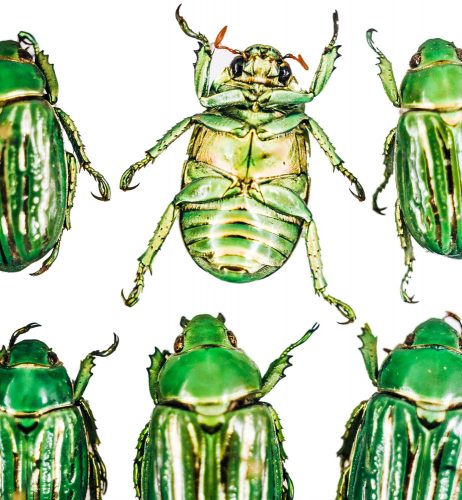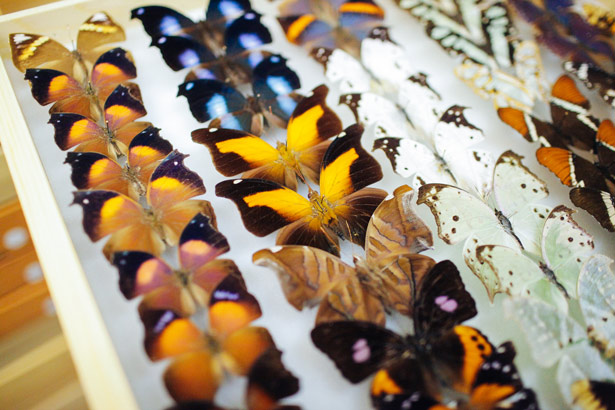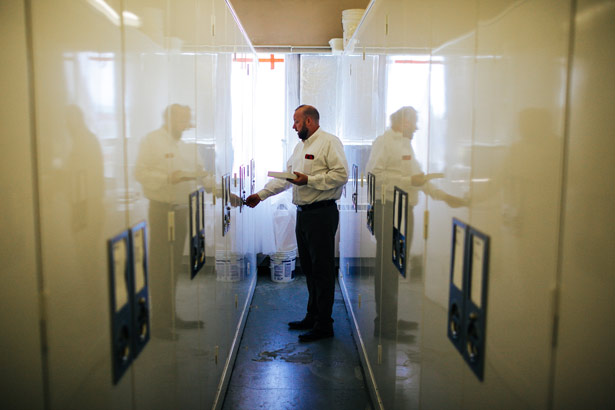
In a dark corner of Cordley Hall on the edge of Oregon State University campus, an unsorted knot of dead ants floats preserved in a clear solution. For all anyone knows, the thumb-sized vial could hold an undiscovered species or a clue to some future entomological breakthrough.
As curator of OSU’s arthropod collection, Chris Marshall is in charge of almost three million dead bugs, as well as some spiders and mollusks.
On a shelf behind Marshall rests a titan beetle bigger than a toddler’s shoe: “Everyone wants to see these,” he says. Drawers and drawers full of little grey dipteras (flies), though, “you have to be a serious bug nerd to appreciate.”
When he took over OSU’s collection 10 years ago, the bug museum was on the verge of collapse. “It looked like someone’s garage,” he says.
Rows and rows of clean, state-of-the-art museum cabinets now protect a vast library of bugs pinned carefully in place under glass.
Some specimens wait patiently dead in old coffee cans and Tupperware to be cataloged. “It’s more work than you can possibly do, ” he says.
Next to the world famous California Academy of Sciences, OSU has the best butterfly collection on the West Coast, Marshall says. Its wasp holdings are “globally important,” rivaling those housed by the Smithsonian Institute.
“Our mite collection is fifth in the world,” he adds, though “we try to avoid pissing contests because we don’t win.”

Marshall waxes almost poetically, talking about science and its current bind: Today’s college kids are drawn to the romance of the sciences, he says, but there isn’t much room for that in today’s classroom or the professional world that follows.
He meets a lot of eager science students who come to him and say, “I love bugs.” He doesn’t for a second doubt their sincerity, but he wonders if they’re cut out for the slow, modern technical approach to entomology.
Science careers in the new millennia perhaps aren’t as sexy as they once were, particularly those available to biology grads, and Marshall worries student verve gets blunted once they realize there isn’t as much use for fieldwork anymore and scant promise of any thrilling eureka moments ahead.
A shaggy student sits nearby at a slate-topped lab table, sorting and cataloging a box of mites. Many times smaller than pinheads, the little creatures sit glued to clear plastic slides. He picks each one out of the box and examines it closely before scratching some indecipherable notes on paper and filing them away in their proper place.

Early in Marshall’s entomological studies, he envisioned for himself an outdoorsy future, all jungles, bug nets and killing jars. But the halcyon Jean-Henri Fabre days of crouching over a backyard anthill, recording your observations in a notebook and publishing them in scientific journals, are long over.
Taxonomy in 2016 can be thankless work that pushes fields of biology forward at a glacial pace.
But that makes it no less important.
“A world without taxonomists,” he says, “can’t describe or name species. Discovering a new species is a lot of work. You don’t just walk out in the field and discover that a species is new.”
Without taxonomy, he adds, we’d be at a loss to protect threatened or endangered species.

Marshall sometimes wonders if natural science courses would fit better in the OSU College of Liberal Arts.
“Writers and artists face a lot of the same problems,” Marshall says, “but the sciences are expected to be more practical.”
Science may be losing its whiz-bang appeal, but Marshall says youngsters are rediscovering the natural sciences.
When asked what gives him that idea, Marshall says: “I don’t know. Maybe it’s just one of those things I hope is true.”